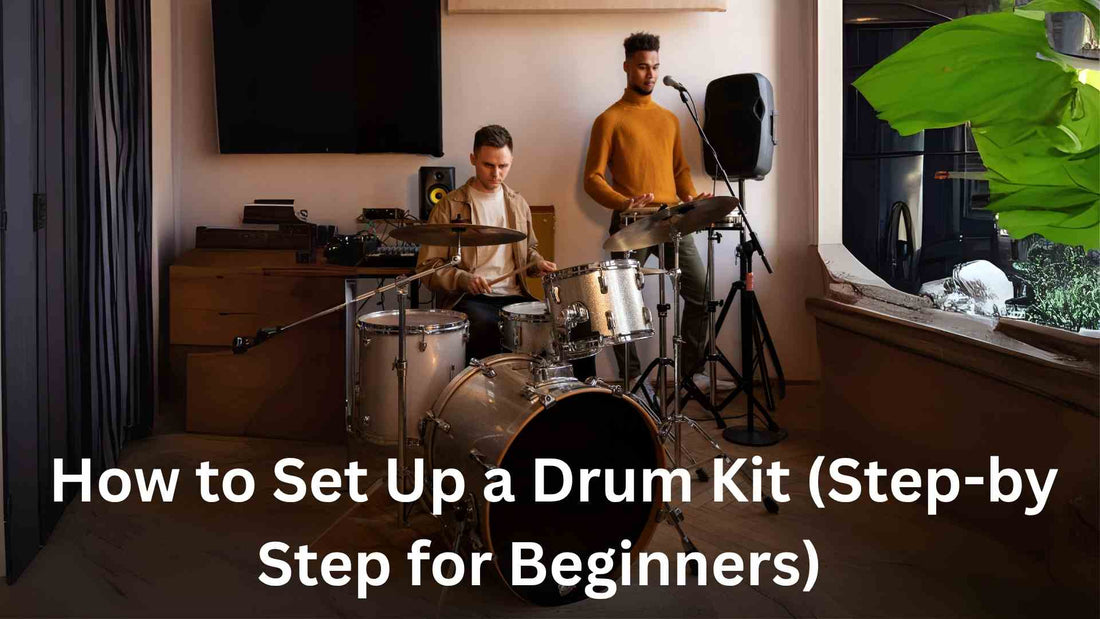How to Set Up a Drum Kit (Step-by Step for Beginners)

Setting up a drum kit can feel like a daunting task for beginners, but it's a gateway to unleashing your musical creativity and laying down the perfect groove. Understanding the core components, like the kick, snare, toms, hi-hats, cymbals, and throne, is crucial for both comfort and playability.
With this beginner drum kit guide, you'll learn how to position each piece to suit your personal style and maximize your drumming potential. We'll also dive into mic placement for drums, exploring dynamic, condenser, and ribbon mics to capture the perfect sound for both practice and recording.
Get ready to transform your space into a personal studio and supercharge your music production skills with essential drum recording techniques.
Essential Drum Kit Components
Let's kick off our journey into drum kit setup by exploring the fundamental pieces that make up a standard kit. Understanding these core components is crucial for both beginners and seasoned drummers alike.
Identifying Core Pieces
A standard drum kit consists of several key components, each playing a vital role in creating the overall sound and rhythm. Let's break down these essential pieces:
1. Kick Drum: Also known as the bass drum, this large drum sits on the floor and is played with a foot pedal.
2. Snare Drum: The sharp, crisp sound of the kit, typically positioned between your legs.
3. Toms: Usually two or three drums of different sizes, mounted on the kick drum or on stands.
4. Hi-Hat: A pair of cymbals mounted on a stand with a foot pedal to control their opening and closing.
5. Cymbals: Including crash and ride cymbals, these add accents and sustained tones to your playing.
Remember, the drum throne (seat) is also a crucial part of your setup, ensuring comfort during long playing sessions.
Positioning for Comfort and Playability
Setting up your drum kit for optimal comfort and playability is essential for developing good technique and preventing injury. Follow these guidelines to position your kit effectively:
Start with the drum throne. Adjust its height so your thighs are parallel to the ground or slightly angled downward. This provides a stable base for your playing.
Position the snare drum between your legs, with the top rim at about navel height when seated. The kick drum should be centered, with the pedal easily reachable by your dominant foot.
Arrange the toms so they're angled slightly towards you, forming a semicircle around the snare. The hi-hat should be placed within easy reach of your non dominant hand, typically to the left for right-handed players.
Finally, position your cymbals at a comfortable height and angle, ensuring you can reach them without straining. Remember, these are general guidelines - feel free to adjust based on your personal comfort and playing style.
Advanced Mic Placement Strategies
Once you've set up your drum kit, the next step is to capture its sound effectively. Proper mic placement is crucial for achieving a balanced, professional-sounding recording.
Kick and Snare Mic Techniques
The kick drum and snare form the backbone of most drum patterns, making their mic placement particularly important. Here's how to mic these core components:
For the kick drum, place a dynamic mic inside the drum, near the beater for more attack, or towards the center of the resonant head for a fuller sound. Some engineers use two mics - one inside and one outside - for more options during mixing.
The snare typically requires two mics: one on top and one on the bottom. The top mic captures the stick attack and should be placed about 1-2 inches above the rim, angled towards the center. The bottom mic picks up the snare wire sound and is placed underneath, aimed at the snares.
Remember to check for phase issues when using multiple mics on a single drum. Adjust the placement or use a phase reverse switch if needed.
Toms and Cymbals Mic Options
Capturing the full spectrum of your toms and cymbals requires careful mic selection and placement. Here's how to approach it:
For toms, close miking is typically the best option. Place dynamic mics about 1-2 inches above the rim of each tom, angled towards the center. Clip-on mics can be a space-saving alternative to traditional mic stands.
Cymbals, especially crash and ride, benefit from a more delicate touch. Ribbon mics are an excellent choice for their smooth high-end response. Position them 6-
12 inches above the cymbal edge, angled slightly away from the center to avoid overly harsh transients.
For a more natural cymbal sound, you might rely more on overhead mics (discussed in the next section) rather than close-miking each cymbal individually.
Overhead Mic Configurations
Overhead mics capture the overall sound of the kit, providing a cohesive blend of drums and cymbals. There are two main configurations to consider:
1. XY Configuration: Two matched condenser mics are placed close together, angled at 90 degrees to each other. This provides a focused stereo image and good mono compatibility.
2. Spaced Pair: Two mics are placed apart, typically above the left and right sides of the kit. This can provide a wider stereo image but may have phase issues in mono.
Regardless of the configuration, aim to position the overheads about 3-4 feet above the kit, equidistant from the snare drum. This helps maintain proper phase relationship and ensures the snare remains centered in the stereo image.

Drum Tuning and Recording Tips
The final touches in your drum recording setup involve understanding microphone types, tuning your kit, and considering mixing and ear protection. These elements can significantly impact your final sound.
Understanding Microphone Types
Choosing the right microphone type for each drum kit element is crucial for capturing the best sound. Here's a quick overview:
Dynamic Mics: Ideal for high SPL sourc
es like kick drums and snares. They're rugged and can handle loud sounds without distortion.
Condenser Mics: Great for overheads and room mics due to their sensitivity and extended frequency response. They capture the nuances and air around the kit.
Ribbon Mics: Excellent for cymbal overheads or as room mics. They have a smooth high-end response that can tame harsh cymbals.
When selecting mics, consider the character of each drum and cymbal. Experiment with different mic types to find the best match for each element of your kit.
Drum Kit Tuning Tips
Proper tuning is essential for getting the best sound out of your drum kit. Here are some key tuning tips:
1. Start with the kick drum, tuning it to a low pitch for a full, resonant sound.
2. Move to the snare, tuning the top head higher than the bottom for a crisp attack.
3. Tune the toms in descending order, with each tom slightly lower in pitch than the one above it.
Use a drum key to adjust the tension rods evenly around each drum. Aim for a clear, singing tone without overtones. Remember, tuning is an art - trust your ears and adjust to taste.

Final Mixing and Ear Protection
When it comes to mixing your drum recordings, less is often more. Start with these tips:
• Balance the levels of each mic carefully, using the overheads as a base and blending in close mics for definition.
• Use EQ sparingly to remove unwanted frequencies and enhance the natural
sound of each drum.
• Apply compression judiciously to control dynamics without squashing the life out of the performance.
Lastly, don't forget about ear protection. Drums can produce high sound pressure levels that can damage your hearing over time. Invest in a good pair of musician's earplugs or isolation headphones to protect your ears during both practice and recording sessions.
Remember, the key to great drum recordings lies in the combination of proper setup, thoughtful mic placement, and careful mixing. With practice an experimentation, you'll develop your own techniques for capturing the perfect drum sound.
No comments










0 comments